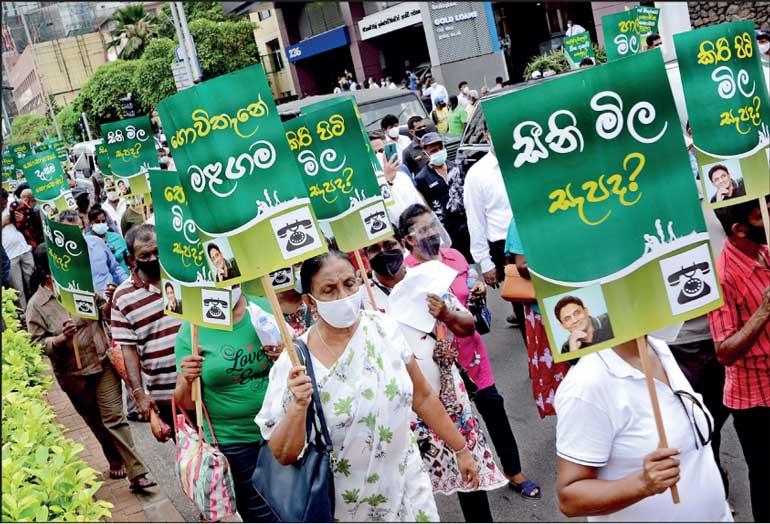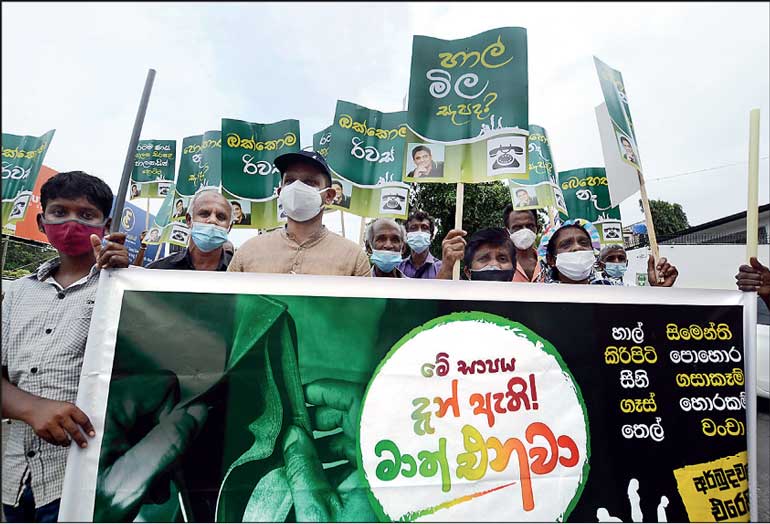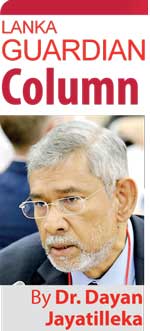Saturday Nov 22, 2025
Saturday Nov 22, 2025
Thursday, 18 November 2021 01:30 - - {{hitsCtrl.values.hits}}


On 16 November, cut off from the inflow of its supporters from the provinces by roadblocks by the Police and in some cases the Army, the SJB was nonetheless able to mobilise under the noses of a vigilant regime and in the epicentre of State power, an impressive “flash” demonstration in the Colombo streets, within sight of the Port City – Pix by Shehan Gunasekara
|
 In March-April 1992, President Premadasa permitted Opposition MP Mahinda Rajapaksa’s 18-day-long march of anti-Government protest and agitation from Colombo to Kataragama—the ‘Paada Yatra’—to proceed unimpeded though it was a time of intense terrorist attacks and war and could have been banned on grounds of security.
In March-April 1992, President Premadasa permitted Opposition MP Mahinda Rajapaksa’s 18-day-long march of anti-Government protest and agitation from Colombo to Kataragama—the ‘Paada Yatra’—to proceed unimpeded though it was a time of intense terrorist attacks and war and could have been banned on grounds of security.
Almost 30 years later, President Gotabaya Rajapaksa, who having migrated to the USA by then didn’t participate in his brother’s Paada Yatra, sought to suffocate Opposition Leader Sajith Premadasa’s one-day protest of 16 November on grounds of COVID.
The heavy Police crackdown and threats of post-protest prosecution prove that the regime is unmindful of the need to secure GSP+.
A wise leader facilitates the channelling of mounting social rage into peaceful protest by moderate democratic parties. Such protests are safety-valves. Thwarting organised peaceful protest by moderates, eventually generates explosive spontaneous protests by the masses.
The new Opposition
On 16 November, cut off from the inflow of its supporters from the provinces by ‘500 roadblocks’ by the Police and in some cases the Army (on the Puttalam-Anuradhapura Road), the SJB was nonetheless able to mobilise under the noses of a vigilant regime and in the epicentre of State power, an impressive “flash” demonstration in the Colombo streets, within sight of the Port City.
Wherever in the island it was prevented from proceeding by the Police, the SJB flipped the stoppage by transforming it into a protest. The regime’s obstructionism backfired as the incoming protest spontaneously decentralised into dozens of localised exercises in anti-regime street theatre. The dozens of locations in which this happened, as seen on TV news, showed that the youngest party had established itself as a far-flung network of motivated supporters and local leaders.
The SJB has clearly established itself as the successor to the UNP, taking over its role, not of the decades of depletion under Ranil Wickremesinghe, but of the JR-Premadasa years of renovated, robust ‘Satyagrahi’ opposition of 1973-1977. Little wonder since the SJB is founded and led by the son of the Deputy Leader of the UNP and the Opposition of that time.
The political contest is clearly between the ruling SLPP and the SJB. The SJB is the main (and mainstream) challenger, while its Leader Sajith Premadasa, Opposition Leader and a natural-born charismatic-populist orator, is indubitably the front-runner in the national leadership stakes.
President Gotabaya Rajapaksa has attempted a tilt against the SJB and to the JVP-NFF. The Police blockade of the SJB demonstrators seemed symptomatic of this tilt.
President GR signalled his tilt in his widely-circulated remark that he was elected due to the failures of the previous administration and if his administration fails, then no purpose would be served by re-electing those who had held power before, and that it would make more sense to elect a new force/formation. His statement got considerable traction and sounds commonsensical. But does it make good sense?
When the Head of the Ceylon National Congress (CNC), D.S. Senanayake, formed the UNP in 1946 with many members of the CNC (minus the Communists), a new chapter opened.
When S.W.R.D. Bandaranaike and the President’s father D.A. Rajapaksa crossed the floor and founded the Sri Lanka Freedom Party (SLFP), no one regarded that party as consisting of those who had been in power until then, or questioned SWRD on that score. Instead, it was recognised as a new alternative.
When Mahinda Rajapaksa, who had served in Cabinet for two terms during the Chandrika presidency, became the candidate and later the SLFP Leader, no one held against him his presence during policies he did not support, such as the PTOMS with Prabhakaran.
The JVP has been around since 1965 and engaged in peaceful democratic politics uninterruptedly since 1994—hardly qualifying as a new force. It was in a provisional coalition almost 20 years ago but never produced a Chief Minister or Mayor of a significant city. Anura Kumara Dissanayake has led the JVP for seven years.
Logically therefore, the island’s youngest party, the SJB, founded and headed by a youthful personality—Sajith Premadasa is just a year older than Anura Kumara Dissanayake—most clearly qualifies as the “new force”.
Those facts notwithstanding, President GR has reason to tilt to the JVP against the SJB. The Rajapaksa regime’s challenger is (secondarily) the SJB and (primarily) Sajith Premadasa who lost to the skyrocketing GR two years ago by only 10% and missed the magic 50% mark by only 8%. Tilting to the smaller third-party and its putative candidate makes sense.
It won’t work: (1) Given public anger at the callous regime and Sajith Premadasa’s “caring, sharing” yet combative populist vibe, it is likely that the Opposition Leader has clawed back most of the 8%-10% shortfall of two years ago. (2) The Sri Lankan voter doesn’t waste a ballot on a third-party presidential candidate. When the Parliamentary Election comes after the Presidential, the Presidential has a knock-on effect on the Parliamentary. But there’s Plan B.
In his commemorative speech of 13 November on the 32nd anniversary of the JVP’s second uprising Anura Kumara Dissanayake said that “…as then (“edaa vageyma”) the battle for the independence of the Motherland, the struggle for the independence of the Motherland, is before us…” (Mts 23:39-23:45, Anura Dissanayake, 13 November – https://www.youtube.com/watch?v=sO2Ou25p2Tk)
President GR knows there’s no downside to his tilt: it would be far easier to motivate the military to suppress its old enemy that still displays huge representations of Rohana Wijeweera, than to move against the moderate, mainstream SJB led by a former President’s son. Therefore, boosting the JVP to enhance its share in the social movement and Oppositional spaces makes for the right target profile and easier sealing of those spaces if push (or putsch) comes to shove.
|
New model, new movement
President Gotabaya Rajapaksa has too much political power and too little political experience. His extreme concentration of power through the 20th Amendment, instead of re-balancing the 19th or diluting the 20th has contributed mightily to the country’s current crisis. True, the classic model of the Jayewardene presidency prior to the 13th Amendment was much the same, but its occupant was one of South Asia’s most experienced politicians: there is a photograph of JRJ seated legs-folded on the Congress platform with Nehru and others while Mahatma Gandhi declares the Quit India Movement in 1942. When someone with no such political experience restores a hyper-centralised presidency and avoids the negotiated settlement of issues –unlike the most powerful President in the world, the President of the USA who personally negotiates with those on both sides in the Congress—it generates needless turbulence and pulls the country into it.
Ministers presented a proposal to Cabinet suggesting that 50% of the needed chemical (urea) fertiliser be supplied immediately and reduced over the next year to 25%. The proposal met the same fate as that of the Ministerial committee appointed by the PM on the 20th Amendment. The President shot it down saying that it was too late for that, and that any requirement should be met with adequate supplies of “nano-nitrogen”. Meanwhile the rains are washing away the nano-nitrogen (as predicted).
The main outcome of year 2 of the GR presidency is the proliferation of protests from all sectors and almost all parts of the island. These are not ideological or political movements. They are SOCIAL movements, people’s movements, grassroots movements.
The most distinctive phenomena of the Gotabaya Presidency have been (a) the militarist mindset in policy-making and the intrusion of the military into administration, and (b) a crisis that has enlarged from the economic to envelop the social; a crisis of social immiseration and alienation and resultant unprecedented mobilisation of almost all social sectors. GR’s new governance model has given birth to the new social movement(s).
NGO-based ‘identity-peace-reconciliation’ civil society should exit their enclave; embrace the people’s socioeconomic causes and the people’s movements, to contribute effectively.
A troika of memories are most symbolic of the GR presidency’s year 2: (i) Sinhala peasantry rejecting the opening of the sluice gates for cultivation (ii) Medamulana farmers marching in the direction of the Rajapaksas’ ancestral residence, and (iii) the (presidential) choice of Ven. Gnanasara (Lanka’s Wirathu) as head of the Presidential Task Force on One Country, One Law.
The rejection or non-utilisation of water for irrigation is the complete negation of an age-old civilisational tradition as well as of a contemporary-historical landmark. In 2006 Mahinda Rajapaksa sent in the army to liberate the Sinhala peasantry from the shut-off of water by Prabhakaran’s Tigers. Today the peasantry rejects the water gushing from the sluice gates as useless because of the shut-off of chemical fertiliser, pesticides and weedicides by President Gotabaya Rajapaksa who was instrumental as Secretary/Defence in deploying the Army to protect the peasantry and the harvest in Mavil Aru.
Quad game
As year 3 commences, President GR has forfeited support nationally and is gradually being encircled internationally. In the California courts, the UNHRC Geneva, at the People’s Tribunal in the Hague and in the complaint by a private law firm to the ICC Chief Prosecutor (endorsed by Canadian lawmaker Rita Sitsabeisan), key names and incidents (e.g., ‘White Flag,’ ‘Isaipriya video’) have already come up.
On President MR’s watch and in wartime (2007), the Sri Lankan nominee, Dr. Rohan Perera, a Lakshman Kadirgamar protégé and senior legal advisor to the Foreign Ministry, was elected to the prestigious International Law Commission. On President GR’s watch and in peacetime (2021), Mohan Peiris PC, former Attorney-General, Chief Justice and currently PRUN-New York, recently ran for the same ILC and lost.
The regime’s policy of (apparent) balancing has been to give away economic real estate to India (e.g., the Adani group against which there have been demonstrations in India and Australia) and the USA. Both moves have led to an uptick in trade-union agitation as well as fissures in the ruling coalition.
|
GR’s approach can work in diverting/deflecting the Quad only if the latter believes that the failed or outdated Clinton policy towards China somehow works for Sri Lanka. Growing economic ties with the West did not alter China’s trajectory or behaviour. The determinant factor is not economic enmeshing. It is the character of the state and regime. Of course, the ancient Greeks knew that—hence the Aristotelian differentiation between and categorisation of political orders, and the focus on the distinctive ‘ethos’ of each regime.
The deep penetration by and interlock with China—the ‘strategic partnership’—will remain so long as the Gotabaya model of state and the Rajapaksa regime do: a militarised autocracy atop an avaricious oligarchy. This will generate efforts to contain, constrain and countervail on the part of the Quad.
The strategic partner, China, has embarrassed the Gotabaya administration by permitting and diplomatically assisting (through tweets, and blacklisting the People’s Bank) the targeting by a Chinese corporate entity of a Sri Lankan state institution and a state official. The company has now threatened to report Sri Lanka to the FAO. In terms of the impact on goodwill, public opinion and Sino-Sri Lanka relations overall, this seems a case of what Zhou Enlai once described as [a state] having “lifted a stone drop on its own feet”.
Counterfeit cult
A personality cult depends on the personality. The Gotabaya personality cult of 2019, epitomised by the exultant martial chant of the zealous campaign song—“Goh-TAH-Bhaya!”—now seems a very bad trip to those who were carried along and voted for it, judging by what they say for TV news cameras while in paddy fields or stuck in queues.
Caricatured effigies of MR have been unthinkable until now, i.e., under his brother’s Presidency and the consequences of its policies. The larger-than-life MR image arose out of appeal, attraction, achievement and affection. For the most part (barring the cringe-worthy ‘Maharajaneni’ moment), it was authentic and ‘organic’.
The GR cult was synthetic; based on an exaggeration and a fiction by ultranationalist-militarist ideologues, starting a decade ago. Ambassador Chandraprema’s book ‘Gota’s War’ (2012) was misnamed, but the historical-factual fakery of the title was a signal of the intentional commencement of a counterfeit cult. In reality, it wasn’t ‘Gota’s War,’ it was Mahinda’s, Sarath Fonseka’s and Gota’s war – just as Bertram D. Wolfe’s famous book on the October Revolution of 1917 was accurately titled ‘Three Who Made a Revolution,’ referring to Lenin, Trotsky and Stalin.
That ‘Gota’s War’ was the first-ever military victory over terrorism of the 21st century was another counterfeit claim (in official discourse too). The Russian State and military under Putin had smashed the Chechen separatist-terrorist militia (with its thousands of foreign fighters), held elections and commenced withdrawal when Sri Lanka beat the Tigers in May 2009. Angola had killed Savimbi and won its 27-year-long civil war seven years before Sri Lanka did.
Compassion deficiency
The personality cult has lost credibility and currency. If anything is at lower levels than the regime’s stash of dollars, it is its “soft power”.
This island has four major religious faiths overlapping to place a high premium on the quality of compassion. In two years as President, Gotabaya Rajapaksa has demonstrated a complete lack of compassion, most noticeably but hardly exclusively, towards the soul of the Sinhala social formation, the peasantry. In so doing, he risks being remembered not so much as the manager of the successful war effort but as the man who whimsically wrecked harvests and livelihoods of the rural peasantry, causing scarcity and hunger.
The main cost of the President’s colossal blunder is not economic or even social—though it encompasses both dimensions—but ethical and moral. A leader without compassion lacks the ‘moral capital’ (Prof. John Kane) necessary for political sustainability and reinvestment. At a time of intense material crisis in a nation with a democratic ethos, a leader’s compassion deficiency or deficit renders even a single term fraught and a second term improbable.
When C.V. Wigneswaran, a former Judge of the Supreme Court, took oaths as the Chief Minister of the Northern Provincial Council, President Mahinda Rajapaksa predicted to some (Tamil) invitees on the occasion of the swearing-in (at which I was present) that nominating Wigneswaran would prove Sampanthan’s most unwise decision. MR observed that the “nadukaaraya” (Judge) was temperamentally incapable of changing into “aandukaaraya” (Governor), and when the “aandukaaraya” continues to think and act as “nadukaaraya,” failure would follow.
For two whole years, Gotabaya Rajapaksa has failed to transition temperamentally from decorated Colonel of the Gajaba regiment and successful Secretary/Defence, to democratic President.
GR had the best possible role-model and potential guru, but instead chose to internalise his CO Gen. Vijaya Wimalaratne rather than President Mahinda Rajapaksa as ideological inspiration, leadership model and guide for a democratic presidency.
Gotabaya Rajapaksa never wore the trademark maroon shawl (“saatakaya”) of his family—a symbol of the main crop, maize, of the peasantry of their native place in the deep south. At his investiture he publicly doffed the shawl that Mahinda placed on him. However, he sports his military decorations on many official occasions.